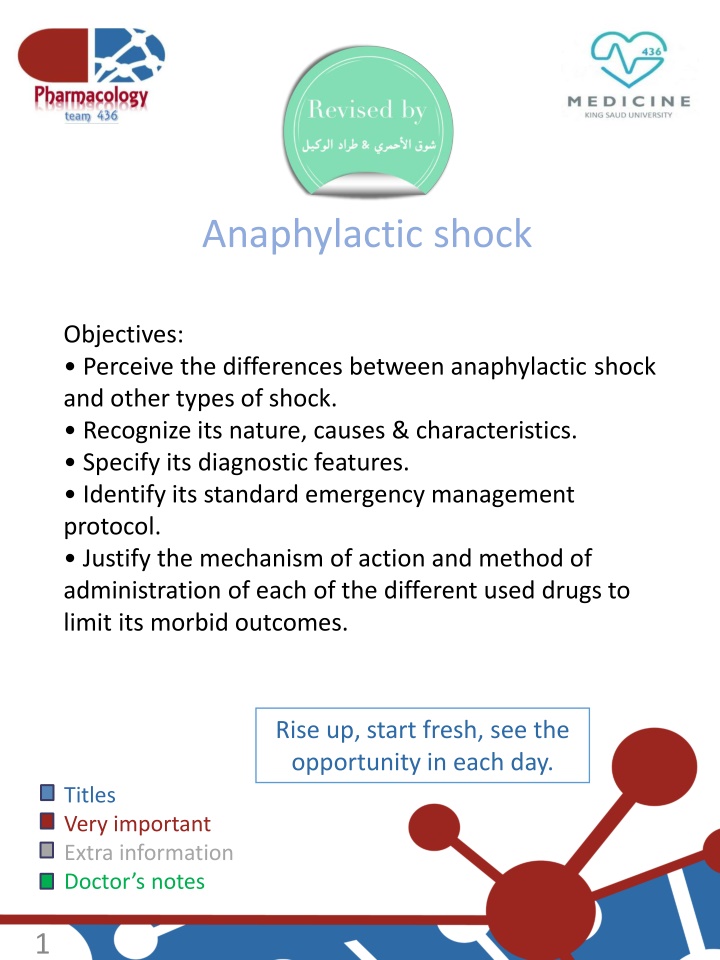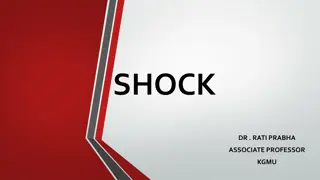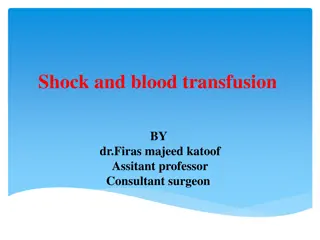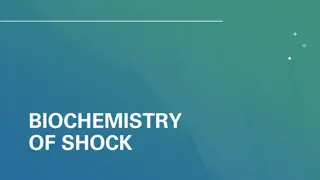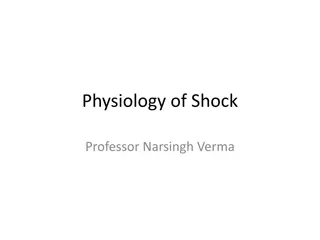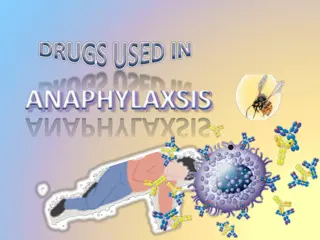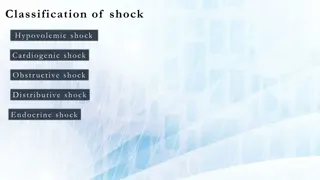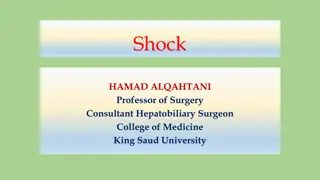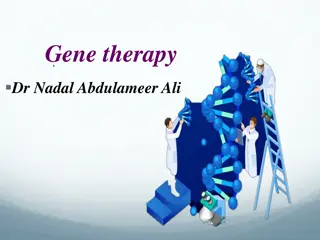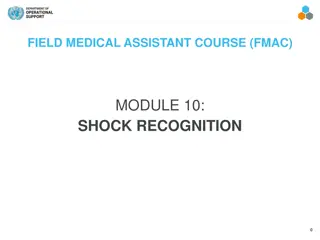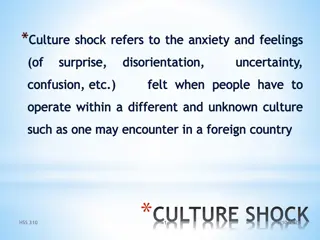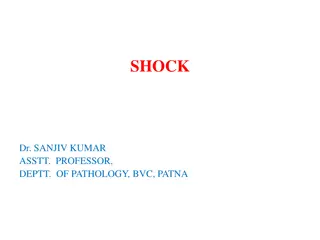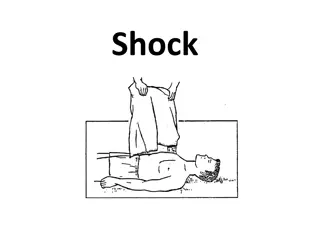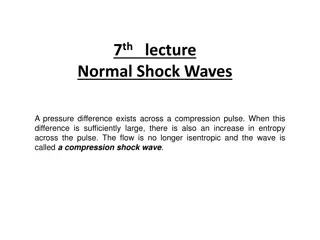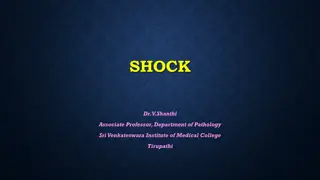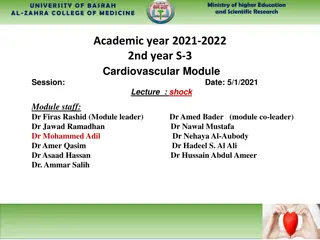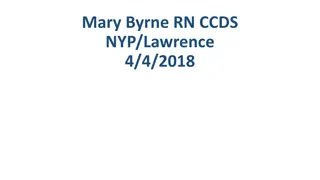Anaphylactic Shock: Diagnosis, Management, and Drug Therapy
Anaphylactic shock is a life-threatening allergic reaction that can lead to shock and airway swelling. Learn about the differences from other types of shock, diagnostic features, emergency management protocol, and drug therapy to limit morbid outcomes. Discover the nature, causes, and characteristics of anaphylactic shock, as well as the mechanisms of action and administration of different drugs used in its treatment.
Download Presentation

Please find below an Image/Link to download the presentation.
The content on the website is provided AS IS for your information and personal use only. It may not be sold, licensed, or shared on other websites without obtaining consent from the author.If you encounter any issues during the download, it is possible that the publisher has removed the file from their server.
You are allowed to download the files provided on this website for personal or commercial use, subject to the condition that they are used lawfully. All files are the property of their respective owners.
The content on the website is provided AS IS for your information and personal use only. It may not be sold, licensed, or shared on other websites without obtaining consent from the author.
E N D
Presentation Transcript
Anaphylactic shock Objectives: Perceive the differences between anaphylactic shock and other types of shock. Recognize its nature, causes & characteristics. Specify its diagnostic features. Identify its standard emergency management protocol. Justify the mechanism of action and method of administration of each of the different used drugs to limit its morbid outcomes. Rise up, start fresh, see the opportunity in each day. Titles Very important Extra information Doctor s notes 1
Anaphylaxis Is a sudden, severe hypersensitivity reaction affecting the whole body (generalized or systemic) in response to allergen. Symptoms Mucosal swelling Difficulty breathing Blood pressure (hypotension) Rash ANAPHYLACTIC SHOCK A life-threatening allergic reaction that causes shock (hypoperfusion) and airway swelling. Anaphylactic shock is a term that specifically refers to an episode of anaphylaxis. Generalized circulatory derangement causing multiple organ HYPOPERFUSION [Inadequate oxygen delivery to meet metabolic demands ] & strong sympathetic activation. If the shock is intense or sustained enough, it will lead to irreversible derangements sets then to permanent functional deficit or death. SHOCK Adrenoceptors: Alpha1:vasoconstriction. Beta1:restore heart function(heart muscles contraction). Beta2:bronchodilation. 2
Types of shock Type Caused by Hemorrhage fluid loss (plasma, ECF) e.g. Excessive vomiting Hypovolemic Inability to contract & pump. E.g.: myocardial infarction Cardiogenic Extra-cardiac obstruction: Pulmonary embolism. Cardiac Tamponade. Obstructive Decreased Peripheral* Resistance vasodilation hypotension. As in: septic shock, Neurogenic shock, anaphylactic shock. Distributive *Peripheral resistance is the resistance of the arteries to blood flow. As the arteries constrict, the resistance increases and as they dilate, resistance decreases. Peripheral resistance is determined by three factors: Autonomic activity: sympathetic activity constricts peripheral arteries. Pharmacologic agents: vasoconstrictor drugs increase resistance while vasodilator drugs decrease it. Blood viscosity: increased viscosity increases resistance. What we need for normal blood pressure : 1. Good cardiac output 2. Good vessels walls constriction If the patient is taking B2 blockers salbutamol won t work so antimuscarinics like ipratropium is the drug of choice. 3
ANAPHYLACTIC SHOCK Non-Immunologic Anaphylaxis (ANAPHYLACTOID) Directly act on mast cells Not IgE-mediated Exogenous substances directly degranulate mast cells. E.g. Radiocontrast dye, Opiates analgesics , Depolarizing drugs, Dextrans antithrombotics . An anaphylactoid reaction can occur following a single, first- time exposure to certain agents in non-sensitized patients. NO need for second exposure Immunologic Anaphylaxis (known as ANAPHYLAXIS) It belongs to type I hypersensitivity reaction (IgE) Occurs after exposure to foreign substances [antigen] such as food, insect or animal venom, drugs, blood products. The immune system will then develop antibodies for this antigen and it will remain in the body for a while. After a 2nd exposure to the same antigen in previously sensitized persons (antigenspecific ige are present), IgE binds with mast cell causing its degranulation. Because anaphylactic and anaphylactoid reactions produce the same clinical manifestations and are treated exactly the same way, we use the term anaphylaxis to refer to both conditions. 4
The degranulation of the mast cells will release histamine, Leukotrienes and other inflammatory substances and will lead to: Adrenaline salbutamol Adrenaline Corticosteroids H1antagonist(antihistamine) Adrenaline Adrenaline 3. 4. Circulatory Collapse Hypo-perfusion 1. 47% 88% 33% Shortness of breath Remember when there is to much vasodilatation the body has to compensate by causing tachycardia as a reflex characters of anaphylactic shock: 2. Rapidly developing [ 5/30 min. can be hours ]. Mucous Swelling Rhinitis 16% Angioedema 88% Airway 56% GIT 30% Severe, life-threatening. Multisystem involvement. Mortality: due to respiratory (70%) or cardiovascular (25%). START EMERGENCY TREATMENT ANAPHYLACTIC SHOCK When the diagnosis is made Call ambulance Respiratory support - - Adrenaline IM by auto injector or Syringe Circulatory support : Lay down and raise legs up\fluid replacement Open airway O2 inhalation 5
ANAPHYLACTIC SHOCK THERAPY PROTOCOL To compensate for vasodilation BC vasodilation means you need more blood In skin The doctor said we won t be asked about doses. 6
ANAPHYLACTIC SHOCK THERAPY PROTOCOL Salbutamol, Ipratropium inhalator bronchodilator parental Aminophyline Adjuvant to 2nd line: H1 blocker Phenaramine H blocker Cimetidine H2 blocker Ranitidine For patients taking beta-blocker. glucagon Objective of therapy: To support the respiratory & circulatory deficits To halt (to stop) the existing (the excessive) hyper- reaction To prevent further hyper-reaction of immune system (Biphasic phenomenon ): 2nd release of mediators without re-exposure to antigen (in up to 20% ) Clinically evident 3-4h after the initial manifestations clear 7
1st line Adrenaline A nonselective Adrenergic agonist [ 1, 2, 1, 2 ] Mechanism of action As an adrenergic agonist: Reverses peripheral vasodilation maintains Blood Pressure & directs blood flow to major organs edema reverse hives* ,swelling around face & lips & angioedema** in nasopharynex & larynx As a -adrenergic agonist: 2 effect: Dilates bronchial airways + histamine & leukotriene release from mast cells 1 effect: force of myocardial contraction PHYSIOLOGICAL ANTAGONIST: Attenuates the severity of IgE-mediated allergic reactions Indication: drug of choice * allergic skin reaction causing localized redness, swelling, and itching (see more http://medical-dictionary.thefreedictionary.com/hives) ** a localized edematous reaction of the deep dermis or subcutaneous or submucosal tissues appearing as giant wheals (see more http://medical- dictionary.thefreedictionary.com/angioedema) Action Not given more than 40 years cardiac patient Rare in a setting of anaphylaxsis Contraindications Dysrrhythmias Adverse effect Intamascular (IM), due to: Easily accessible (Auto-injectors Kits: Disposable (use for once) , prefilled devices automatically administer a single dose of epinephrine in emergency) Greater margin of safety, so no dysrrhythmias as with IV No need to wait for IV line, if IV present it given by physician under monitoring Administration Repeat every 5-10 min as needed Patients observed for 4-6 hours. Why ? Fear of biphasic anaphylaxsis If hypotension persist start dopamine For patients taking -blockers because they either: Refractory (not response); as it may antagonize effects of adrenaline Rebound hypertension: [ unopposed a effect], specially when adrenaline is repeated Caution 8
corticosteroids H1 blockers Salbutamol glucagon H2 blockers Aminophylline Ipratropium Has both positive inotropic & chronotropic effects on heart increase cardiac cyclic AMP an effect entirely independent of adrenergic that is why effective in spite of - adrenergic blockade. Efficacy of acting on bronchi less than in heart (no evident bronchodilation) through immediate GCs actions on Membrane-bound receptors modulating levels of 2nd messengers (within seconds or minutes) which means Non-genomic action 2-adrenergic agonist Mechanism of action Though mast cells have already de- granulated (e.g. phenaramine) (anti-ulcer drugs, used for epigastric pain) Anticholinergic Reverse hypotension and bronchoconstricti on, so it will decrease the releasing of inflammatory mediators (anti- chemotactic & mast cell stabilizing effects). Decrease mucosal swelling and skin reaction May help to limit biphasic reactions by decrease allergic mediators 1- Short acting, rapid relief onset relax bronchial smooth muscle and may decrease mediator release from mast cells and basophils. 2- Inhibit airway microvascular leakage. help to counter act histamine- mediated vasodilati on & bronchoco nstriction. May help to limit biphasic reactions by decrease histamine release patients with refractory hypotension treatment of anaphylaxis when inhaled Broncho- dilators are not effective & bronchospa sm is persistent The significance of H2 blockers is not established (e.g. Ranitidine & cimetidine) Less rapid in action Decrease secretion Action Drug of choice for severe anaphylaxis in patients taking - blockers. Not given more than 40 years cardiac patient Rare in a setting of anaphylaxis Contraindications No cimetidine in elderly, renal/hepatic failure, or if on -blockers Given in hospital setting as levels of drug should be Therapeutical ly Monitored because it has narrow therapeutic index associated with serious adverse drug interactions Adverse effect longer duration of action Dysrrhythmias Inhalational Administra 1 mg IV q 5 min until hypotension resolves Ranitidine 50 mg IV slowly intravenously or intramuscularly tion Inhalational 9
More explanation Non-genomic action Genomic action genomic action is slow may take hours to days DNA -blockers contraction contraction cAMP GS cAMP contraction Glucagon Gs Gs M2& M3 - Sympathomimetics Ipratropium 10
SAQ A 12-year-old boy is brought to the emergency department after being stung by a bee. He had been well until he was stung on his right forearm, while playing in the yard. He initially complained of localized pain and swelling. Fifteen minutes later, he began to complain of shortness of breath. His parents observed him to be wheezing, very weak and dizzy. His parents brought him immediately to the local emergency department. His medical history shows that he has allergy. Q1: what is the most likely diagnose in this case ? Anaphylactic shock. Q2: What is the drug of choice in this case ? Adrenaline. Q3: What is the best route of administration for this drug ? Intra-muscular (IM). although we can use IV line but should be given by physician under monitoring. Q4: What is the mechanism of its action ? It is Sympathomimetic drug, so it mimics the effect of Sympathetic system by working as Adrenergic agonist . It is nonselective agonist which act on [ 1, 2, 1, 2, 3 ], some of its action: 1\ In blood vessel, act as agonist which cause vasoconstriction. 2\ In heart, act as 1 agonist which lead to increase the force of myocardial contraction. 3\ In bronchi & bronchioles, act as 2 agonist which cause bronchodilator and decrease histamine & leukotriene release from mast cells . - After 3-4 hours, he may develop what we called Biphasic Phenomenon. Q5:What do we mean by Biphasic Phenomenon? It is a second episode of anaphylaxis with 2nd release of mediators without re-exposure to antigen. Q6: List some drugs we can use it to prevent Biphasic Phenomenon ? 2nd line anaphylaxix s drugs. Such as 1\ Glucocorticoids : Hydrocortisone 2 \ First generation H1 blocker : Chlorophenamine Q7: Later, we can give him some bronchodilators as Adjuvant 2nd line therapy, list some of them? Salbutamol as 2 Agonist. Ipratropium as Anti-muscarinic. Aminophylline as Methyl-xanthine. Zoom in to see the answers 11
QUIZ Boys Girls Contact us : @Pharma436 Pharma436@outlook.com 12
